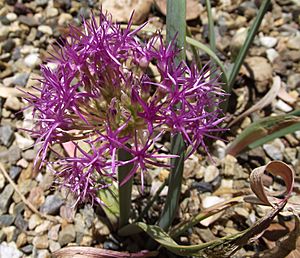Flat-stem onion facts for kids
Quick facts for kids Flat-stem onion |
|
|---|---|
 |
|
| Scientific classification |
The Flat-stem onion (Allium platycaule) is a type of wild onion. It is also known as the broadstemmed onion. This plant grows naturally in parts of northeastern California, south-central Oregon, and northwestern Nevada. You can often find it on mountain slopes, usually at heights between 1,500 and 2,500 meters (about 4,900 to 8,200 feet) above sea level.
What is the Flat-stem Onion?
The Flat-stem onion grows from a gray, round part called a bulb. This bulb is usually about 2 to 3 centimeters (about 1 inch) wide. The plant's main stem, called a scape, is thin and very flat. It can grow up to 25 centimeters (about 10 inches) long. However, it is rarely wider than 7 millimeters (about 0.3 inches) across. The stem might be a bit thicker in the middle and much narrower along its edges.
Leaves and Flowers
The leaves of the Flat-stem onion are long and flat. They are often shaped like a sickle, which is a curved blade. At the very top of the stem, you'll find a cluster of flowers called an umbel. This cluster can have as many as 90 flowers!
Each flower can be up to 1.5 centimeters (about 0.6 inches) wide. The flower parts, called tepals, are very narrow, almost like threads. Because of this, the whole flower cluster can look like a thick ball of tiny threads. The flowers are usually a bright pink or magenta color. They also have yellow parts called anthers in their center.
Traditional Uses of the Plant
For a long time, the Flat-stem onion has been important to people living in its native areas. The Northern Paiute people traditionally used different parts of this plant as food. They would eat the leaves, the bulbs, and even the seeds.

